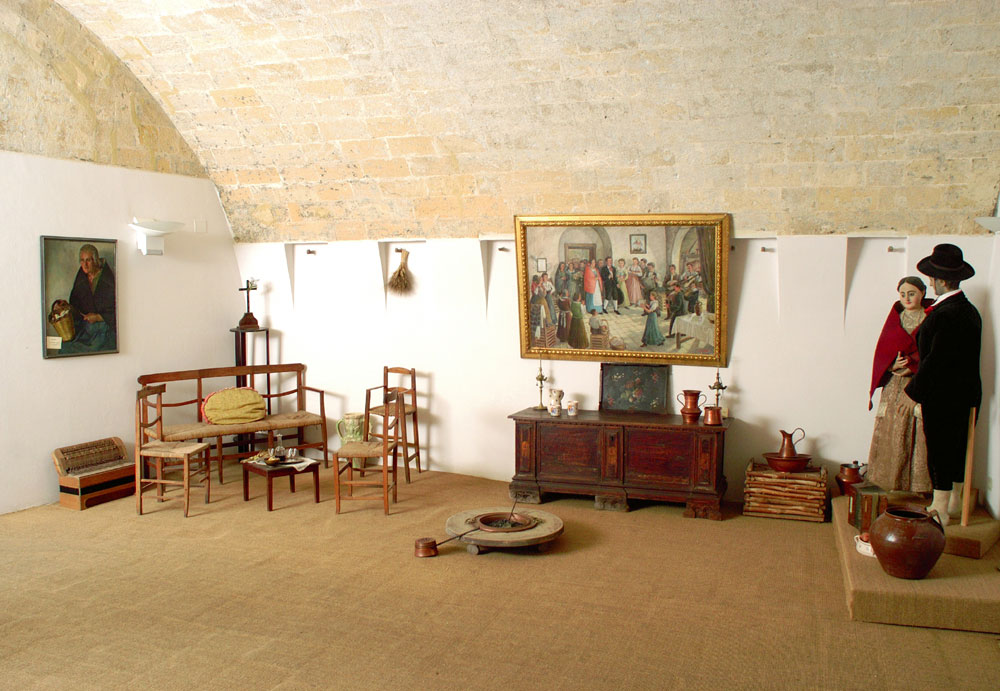- PRENOTAZIONE OBBLIGATORIA PER MUSEO E BIBLIOTECA
Il Museo Fondazione Ettore Pomarici Santomasi si trova in
Via Museo n. 20, Gravina in Puglia (Ba), Italia
come raggiungerci
+39 080.325.10.21
info@fondazionesantomasi.it
Orari
Lun/Ven: 9.00-13.00 | 16.00-19.00
Sabato: 10.00-13.00 | 16.00-19.00
Dom./Festivi: 10.00-13.00
FOLKLORE
Il folklore è la manifestazione di una forza spirituale della collettività umana la quale crea, conserva e tramanda; infatti il termine folklore deriva da due parole folk = popolo e lore = sapere, quindi letteralmente “Sapere del popolo” ed è sinonimo di tradizioni popolari.
Nella sezione del folklore è rappresentato quel complesso di consuetudini, di forme di vita gravinese e di rapporti tradizionali che ha il suo fulcro nel focolare domestico.
L’ambiente proposto vuol riportare alla memoria tutte quelle tradizioni popolari che, negli ultimi cinquant’anni hanno subito uno svuotamento di significato a causa di una lotta al passato e a tutto ciò che si presenta come freno alla modernità.
Due manichini in cartapesta indossano l’antico abito nuziale gravinese del 1800. La sposa indossa un vestito di broccato ornato di pizzi, composto da un giacchettino attillato e gonna ampia con grembiule, arricchito da un coprispalle “u pannarule” (un rettangolo di seta colorata, imbottito e trapunto a mano). Lo sposo indossa un abito nero: la giacca con accollatura alta, i pantaloni lunghi fino al polpaccio, a vita alta, sono fermati da una fascia in tessuto di colore rosso e calzettoni bianchi; la cravatta svolazzante, in raso pesante, su camicia bianca (in tessuto “percalle”) con abbottonatura alta sul pettino e il gilet. Il cappello nero di feltro molle con sottogola in corda
Due manichini in cartapesta indossano l’antico abito nuziale gravinese del 1800. La sposa indossa un vestito di broccato ornato di pizzi, composto da un giacchettino attillato e gonna ampia con grembiule, arricchito da un coprispalle “u pannarule” (un rettangolo di seta colorata, imbottito e trapunto a mano). Lo sposo indossa un abito nero: la giacca con accollatura alta, i pantaloni lunghi fino al polpaccio, a vita alta, sono fermati da una fascia in tessuto di colore rosso e calzettoni bianchi; la cravatta svolazzante, in raso pesante, su camicia bianca (in tessuto “percalle”) con abbottonatura alta sul pettino e il gilet. Il cappello nero di feltro molle con sottogola in corda
Folklore is the expression of a mankind spiritual power that creates, keeps and hands down; in fact, the word folklore comes from two words folk= people and lore= knowledge, so it means literally “people knowledge” and stands for popular traditions. The world of the folklore includes that combination of local traditions and customs that has its core in the domestic life. The exhibition’s task is to focus on all the popular traditions that, during the last fifty years, have lost attraction, as they have often been seen as an obstacle to the modernity. Two papier-mâché manikins have the old local wedding clothes, dated around 1800. The bride wears a brocade dress adorned with laces, a little jacket and a full skirt with apron, enriched by “u pannarule” (a rectangular piece of coloured silk, padded and hand- embroidered) used to cover the shoulders. The bridegroom wears a black suit: a high-neckline jacket, long waist trousers, with a red band and white socks; the ornate satin tie, a white high-neckline shirt (“gingham” fabric), a waistcoat and a black felt hat with chin-strap.
Die Folklore ist die Äußerung einer geistlichen Kraft, die erschafft, macht ein und überliefert; denn der Ausdruck kommt aus zwei Wörtern, folk=Volk und lore=Kenntnis, so “Kenntnis des Volks” ist das Synonym der volkstümlichen Traditionen. In der Abteilung über die Folklore sind alle die Gewohnheiten und Traditionen von Gravina gesammelt. Das Ziel dieser Abteilung ist die lokalen volkstümlichen Traditionen zu erinnern, die in den letzten fünfzig Jahren ihre Bedeutung verloren haben. Zwei Papiermachegliederpuppen ziehen eine alte lokale Hochzeitskleid an (1800). Die Braut zieht ein Kleid aus Brokat mit Spitzen an; es ist aus einer engen Jackett und aus einem großen Rock mit Schürze und Schulterdecke (bekannt als “u pannarule”, ein gepolstertes Hand-gestepptes Rechteck aus bunten Seide) komponiert. Der Bräutigam zieht dagegen ein schwarzes Kleid an: die hochgeschlossene Jacke, die langen Hose mit einem roten Bund und weißen Socken, die Krawatte aus Satin auf dem weißen Perkal-Hemd und die Weste. Der schwarze Hut ist aus Filz gemacht.












